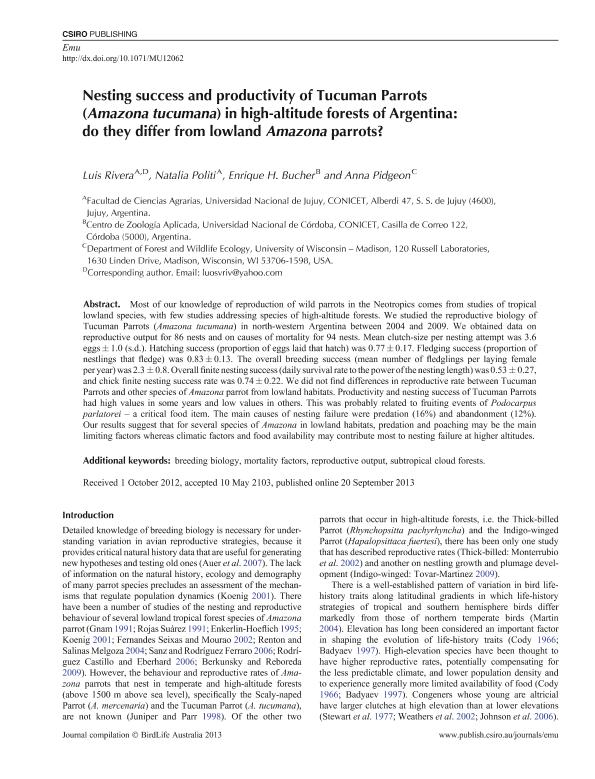Artículo
Nesting success and productivity of Tucuman Parrots
Fecha de publicación:
09/2013
Editorial:
Csiro Publishing
Revista:
Emu
ISSN:
0158-4197
Idioma:
Inglés
Tipo de recurso:
Artículo publicado
Clasificación temática:
Resumen
Most of our knowledge of reproduction of wild parrots in the Neotropics comes from studies of tropical lowland species, with few studies addressing species of high-altitude forests. We studied the reproductive biology of Tucuman Parrots (Amazona tucumana) in north-western Argentina between 2004 and 2009. We obtained data on reproductive output for 86 nests and on causes of mortality for 94 nests. Mean clutch-size per nesting attempt was 3.6 eggs±1.0 (s.d.). Hatching success (proportion of eggs laid that hatch) was 0.77±0.17. Fledging success (proportion of nestlings that fledge) was 0.83±0.13. The overall breeding success (mean number of fledglings per laying female per year) was 2.3±0.8. Overall finite nesting success (daily survival rate to the power of the nesting length) was 0.53±0.27, and chick finite nesting success rate was 0.74±0.22. We did not find differences in reproductive rate between Tucuman Parrots and other species of Amazona parrot from lowland habitats. Productivity and nesting success of Tucuman Parrots had high values in some years and low values in others. This was probably related to fruiting events of Podocarpus parlatorei - a critical food item. The main causes of nesting failure were predation (16%) and abandonment (12%). Our results suggest that for several species of Amazona in lowland habitats, predation and poaching may be the main limiting factors whereas climatic factors and food availability may contribute most to nesting failure at higher altitudes.
Archivos asociados
Licencia
Identificadores
Colecciones
Articulos(IDEA)
Articulos de INSTITUTO DE DIVERSIDAD Y ECOLOGIA ANIMAL
Articulos de INSTITUTO DE DIVERSIDAD Y ECOLOGIA ANIMAL
Articulos(SEDE CENTRAL)
Articulos de SEDE CENTRAL
Articulos de SEDE CENTRAL
Citación
Rivera, Luis Osvaldo; Politi, Natalia; Bucher, Enrique Hugo; Pidgeon, Anna; Nesting success and productivity of Tucuman Parrots; Csiro Publishing; Emu; 114; 1; 9-2013; 41-49
Compartir
Altmétricas




